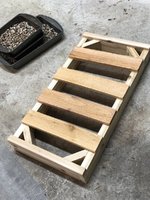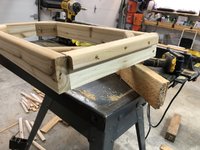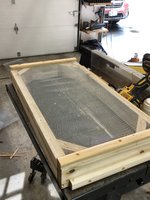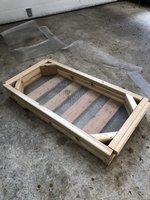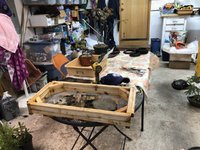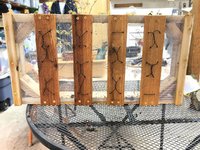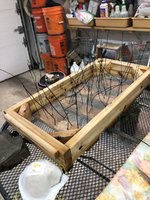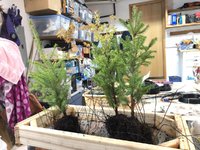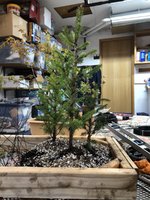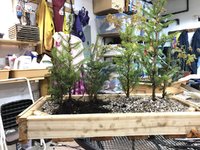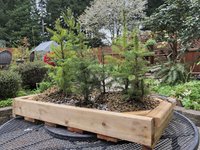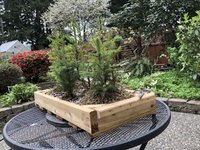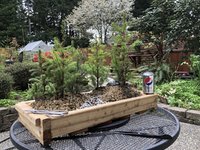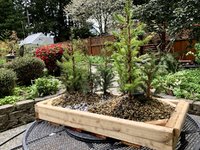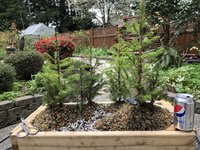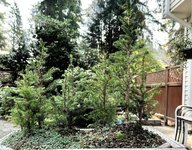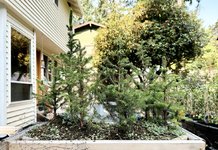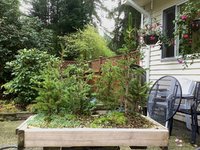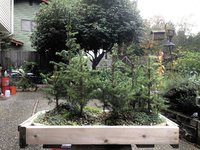Deep Sea Diver
Masterpiece
Over the past two years I’ve been picking up Ezo Spruce seedlings from Bill V and doing a review dive on creation of forests.
Key readings, but not the only ones, for those who are interested were.
I’ve been inspired over the years by viewing and helping maintain some interesting examples of forests. Not that my little starter forest will ever achieve these levels, but here’s one of my very favorite, just for eye candy, shown at the National in 2021. Styled by Aarin Packard of PBM.
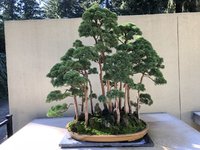
Anyways, these are the basics.
Research done, internal inspiration firing up this hobbyist, I’m faced with the reality of turning a group of little baby dwarfish species of spruce into something that may someday be the core of a decent forest.
Here they are, 8 Ezo spruce seedlings huddled together in the cold Seattle rain. I realize there is an overwhelming need for another tree, but there’s no trees at the inn. Looks like I’ll have to improvise.

The trees again, this time a bit more spread out. Note two different color variations of the same species. Not great, but this is the hand I’m dealt with. One can’t go to the big box or online and get Ezo stock easily…. Maybe with luck, as other stock is added, I can make some replacements… maybe not. Luckily three of the trees have a larger trunk width/height and a fourth almost the same. This will help later.

So that’s the challenge… to discover a way to create a convincing forest with small trees, or not. Well… at least something we can live with for now.
Next phase - build and prep the container.
Cheers
DSD sends
Key readings, but not the only ones, for those who are interested were.
- Forest, Rock Planting and Ezo Spruce Bonsai, Saburo Kato (Luckily I scored a loaner!)
- Int’l Bonsai 5 1993 #1, Creating Group Planting from Established Bonsai, Hatsuji Kato (Saburo Kato’s eldest son)
- Man Lung Artistic Potted Plants, Wu Yee-sun 1979 pp 65-69
- Forest Bonsai - Considerations for creating forest bonsai, Bill Valvanis, 2019 (handout from a lecture.)
I’ve been inspired over the years by viewing and helping maintain some interesting examples of forests. Not that my little starter forest will ever achieve these levels, but here’s one of my very favorite, just for eye candy, shown at the National in 2021. Styled by Aarin Packard of PBM.

Anyways, these are the basics.
Research done, internal inspiration firing up this hobbyist, I’m faced with the reality of turning a group of little baby dwarfish species of spruce into something that may someday be the core of a decent forest.
Here they are, 8 Ezo spruce seedlings huddled together in the cold Seattle rain. I realize there is an overwhelming need for another tree, but there’s no trees at the inn. Looks like I’ll have to improvise.

The trees again, this time a bit more spread out. Note two different color variations of the same species. Not great, but this is the hand I’m dealt with. One can’t go to the big box or online and get Ezo stock easily…. Maybe with luck, as other stock is added, I can make some replacements… maybe not. Luckily three of the trees have a larger trunk width/height and a fourth almost the same. This will help later.

So that’s the challenge… to discover a way to create a convincing forest with small trees, or not. Well… at least something we can live with for now.
Next phase - build and prep the container.
Cheers
DSD sends



